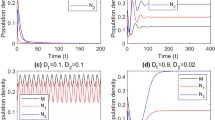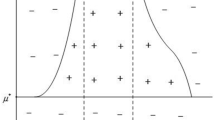Abstract
In this paper, a nonlinear nonautonomous predator-prey dispersion model with continuous distributed delay is studied, where all parameters are time-dependent. In this system consisting of n-patches the prey species can disperse among n-patches, but the predator species is confined to one patch and cannot disperse. It is proved that the system is uniformly persistent under any dispersion rate effect. Furthermore, some sufficient conditions are established for the existence of a unique almost periodic solution of the system. The example shows that the criteria in the paper are new, general and easily verifiable.
Similar content being viewed by others
References
Skellem J D. Random dispersal in theoretical population, Biometrika, 1951, 38: 196–216.
He C. Almost Periodic Differential Equations, Beijing: Higher Education Publishing House, 1992, (in Chinese).
Freedman H I, Rai B, Waltman P. Mathematical model of population interactions with dispersal II: Differential survival in a change of habitat, J Math Anal Appl, 1986, 115: 140–154.
Beretta E, Solimano F. Global stability and periodic orbits for two patch predator-prey diffusion delay model, Math Biosci, 1987, 85: 153–183.
Kuang Y, Takeuchi Y. Predator-prey dynamics in models of prey dispersal in two-patch environments, Math Biosci, 1994, 120:77–98.
Levin S A. Dispersion and population interaction, Amer Naturalist, 1974, 108: 207–228.
Vance R R. The effect of dispersal on population stability in one-species, discrete space population growth models, Amer Naturalist, 1984, 123: 230–254.
Beretta E, Takeuchi Y. Global asymptotic stability of Lotka-Volterra diffusion models with continuous time delays, SIAM J Appl Math, 1988, 48: 627–651.
Kuang Y. Delay Differential Equations with Applications in Population Dynamics, New York: Academic Press, 1993.
Xia Y, Cao J. Almost periodic solutions for an ecological model with infinite delays, Proc Edinburgh Math Soc, 2005, in press.
Xia Y, Cao J. Almost periodicing in an ecological model with M-predators and N-preys by pure-delay type system, Nonlinear Dynamics, 2005, 39(3): 275–304.
Zhang Z Q, Wang Z C. Periodic solutions for nonautonomous predator-prey system with diffusion and time delay, Hiroshima Math J, 2001, 31(3): 371–381.
Chen S H, Wang F, Yong T. Existence of positive periodic solution for nonautonomous predator-prey system with diffusion and time delay, J Comput Appl Math, 2003, 159: 375–386.
Song X, Chen L. Conditions for global attractivity of n-patches predator-prey dispersion-delay models, J Math Anal Appl, 2001, 253: 1–15.
Ayala F J, Gilpin M E, Eherenfeld J G. Competition between species: theoretical models and experimental tests, Theor Popul Biol, 1973, 4: 331–356.
Gilpin M E, Ayala F J. Global models of growth and competition, Proc Nat Acad Sci USA, 1973, 70: 3590–3593.
Fan M, Wang K. Global periodic solutions of a generalized n-species Gilpin-Ayala competition model, Comput Math Appl, 2000, 40: 1141–1151.
Gilpin M E, Ayala F J. Schoener’s model and Drosophila competition, Theor Popul Biol, 1976, 9: 12–14.
Li C R, Lu S J. The qualitative analysis of N-species periodic coefficient, nonlinear relation, prey-competition systems, Appl Math J Chinese Univ, 1997, 12(2): 147–156.
Zhao J D, Chen W C. The qualitative analysis of N-species nonlinear prey-competition systems, Appl Math Comput, 2004, 149(2): 567–576.
Xia Y, Chen F, Chen A, et al. Existence and global attractivity of an almost periodic ecological model, Appl Math Comput, 2004, 157: 449–475.
Xia Y, Cao J, Huang Z, et al. Almost periodic solutions of n-species competitive system with feedback controls, J Math Anal Appl, 2004, 294: 503–522.
Xia Y, Lin M, Cao J. The existence of almost periodic solutions of certain perturbation systems, J Math Anal Appl, 2005, 310: 81–96.
Chen C, Chen F. Conditions for global attractivity of multispecies ecological competition-predator system with Holling III type functional response, Journal of Biomathematics, 2004, 19(2): 136–140.
Author information
Authors and Affiliations
Additional information
Supported by the Start-up Fund of Jimei University (ZB2004009).
Rights and permissions
About this article
Cite this article
Chen, C., Ji, K. Dynamics of a nonlinear non-autonomous n-patches predator-prey dispersion-delay model. Appl. Math.- J. Chin. Univ. 22, 393–404 (2007). https://doi.org/10.1007/s11766-007-0403-2
Received:
Issue Date:
DOI: https://doi.org/10.1007/s11766-007-0403-2




